For this week’s post I am on the edge of Park Lane, in Pitt’s Head Mews between Green Park and Hyde Park, at the bottom of the steps leading up to Curzon Square, or what in 1951 was called Curzon Place:
Despite redevelopment of the buildings on either side of the steps, they are still there, although now with a slight curve in the steps as they lead up to Curzon Square, and with new stone steps, replacing the originals which had probably seen over a century of use:
Pitt’s Head Mews was once full of stables, however today the part of the street that runs up to Park Lane has been completely redeveloped. On the left is the London Hilton Hotel which was built in 1963 on an extensive area between Pitt’s Head Mews and Hertford Street that was destroyed during the blitz.
The stairs are not that visible, tucked away between the two buildings on the right in this view standing in Pitt’s Head Mews looking up to Park Lane
Today, the steps lead up to Curzon Square, however as can be seen in the sign on the left of the 1951 photo, the area at the top of the steps was then called Curzon Place. This is not the only name change.
The following drawing from the book London – Alleys, Byways and Courts by Alan Stapleton, published in 1924 includes this drawing of the steps, looking much as they did when my father took the 1951 photo, however note the caption to the drawing and the sign in the drawing to the top left of the steps – when this was drawn in the 1920s, the area at the top of the steps was called Seamore Place:
Curzon Street originally ran straight into Park Lane. The following map extract from 1832 shows Curzon Street along the middle of the map. Curzon Place is the small area of open space just above the letter ‘M’ in Mews.
By 1895 the area had been redeveloped and Curzon Street was now blocked off from Park Lane. At the end of the street, it turned left into Seamore Place. You can just see the steps leading into Pitt’s Head Mews at the lower right corner of Seamore Place in the following map. At the time this was the shortest route into Curzon Street from the south.
The buildings at the end of Curzon Street were demolished in 1937 which returned the direct access to Park Lane that Curzon Street had in the 1832 map. Seamore Place appears to have been renamed Curzon Place around the 1937 changes.
At the top of the steps, we are greeted with this view of Curzon Square:
There does not appear to be much written about Curzon Square / Seamore Place, however whilst reading the book by Alan Stapleton which included the drawing shown above, I did find the following:
“Seamore Place consists of old-fashioned mansions, but No. 8 was the home of the ‘gorgeous’ Lady Blessington, with whom live here, her daughter and son-in-law, Count d’Orsay. Here nightly, met all the fashion, celebrities of all nations, and travellers from all countries.
Haydon said, ‘Everyone goes to Lady Blessington’s. She has the first news of everything and everybody seems delighted to tell her. She is the centre of more talent and gaiety than any other woman of fashion in London.
She began to edit her ‘Book of Beauty’ here. Willis described her as ‘a woman of remarkable beauty’ and ‘one of the most lovely and fascinating women he had ever seen.”
The Wallace Collection includes the following painting of Lady Blessington, by Thomas Lawrence in 1822 – an early 19th century celebrity:
Edward Walford writing in Old and New London also includes the following description of Seamore Place;
“Seamore Place is the name of a row of handsome but old fashioned mansions, which occupy a sort of cul de sac at the western end of Curzon Street. They are only nine in number, and their chief fronts look westward over Hyde Park. in one of them, Lady Blessington with her daughter and her son-in-law Count D’Orsay, resided during a part of her widowhood, from about 1836 to 1840, surrounded by all the fashionable butterflies of the world whose admiration she so much courted.”
The last time that Curzon Square became well known was in the 1970s. The building shown below is part of 9 Curzon Place. It may look to be a Georgian building of blackened London brick, however the interior of the house was completely gutted just after the last war. The building was converted into 12 apartments and major changes were made including putting a lift shaft up through the central staircase.
The American singer Harry Nilsson owned one of the flats on the top floor, and it was in this flat that firstly Mama Cass Elliot of the band the Mamas and Papas died in 1974 of a heart attack.
This was followed in 1978 by the death in the same flat of Keith Moon, the drummer with The Who, who died of an overdose of Heminevrin which he was taking to help with the symptoms of alcohol withdrawal.
9 Curzon Place was part of a redevelopment of Curzon Square that ended in 2002 and saw the square pedestrianised, along with an underground car park. I believe it was at the time of this redevelopment that the name changed from Curzon Place to Curzon Square.
The entrance to 9 Curzon Square:
The view from Curzon Street looking past 9 Curzon Square. At the far end the steps down to Pitt;s Head Mews can be seen:
Curzon Square today appears to be much quieter than when Keith Moon and Lady Blessington called this part of London home.
I am pleased though, that despite development of the square, the steps – although of recent materials – are still in the same place as when my father photographed them, and Curzon Square is another location I can tick off in the search for all his London photos.

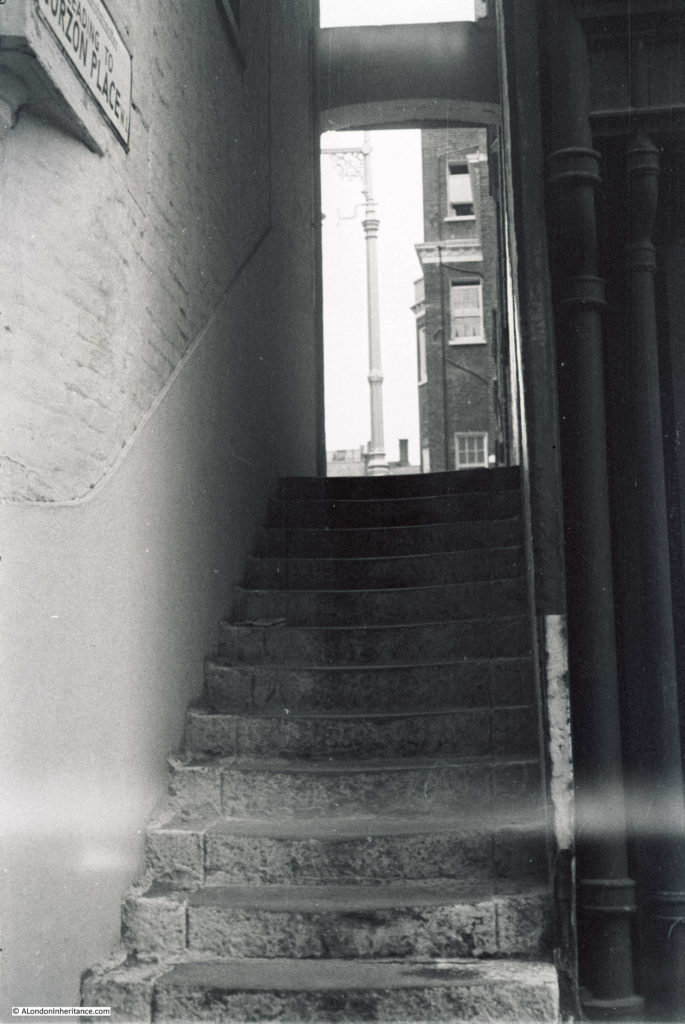

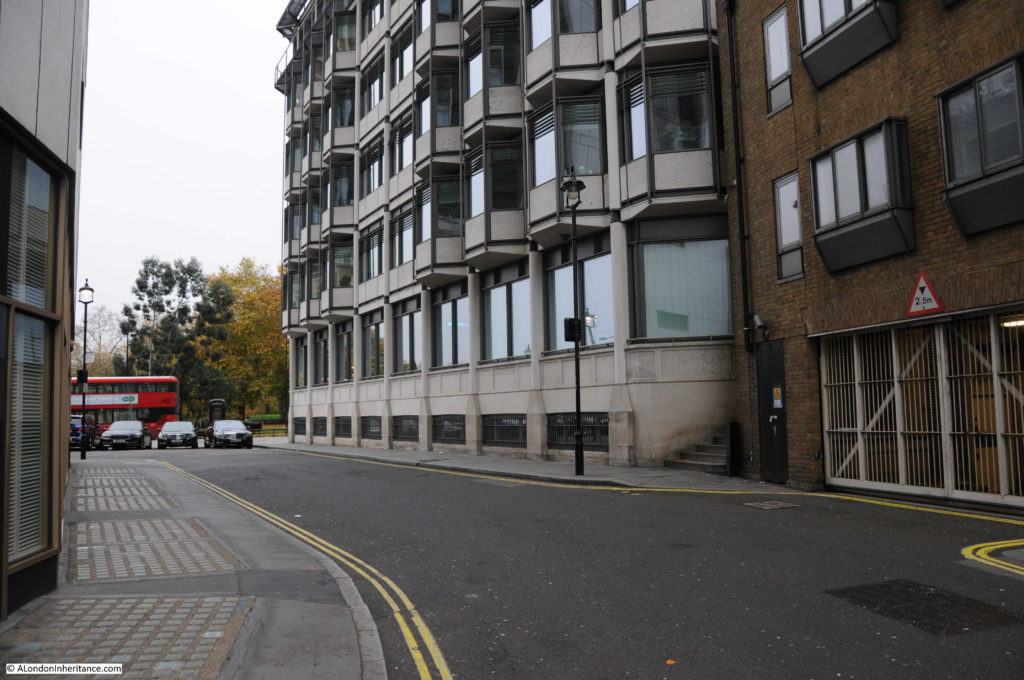
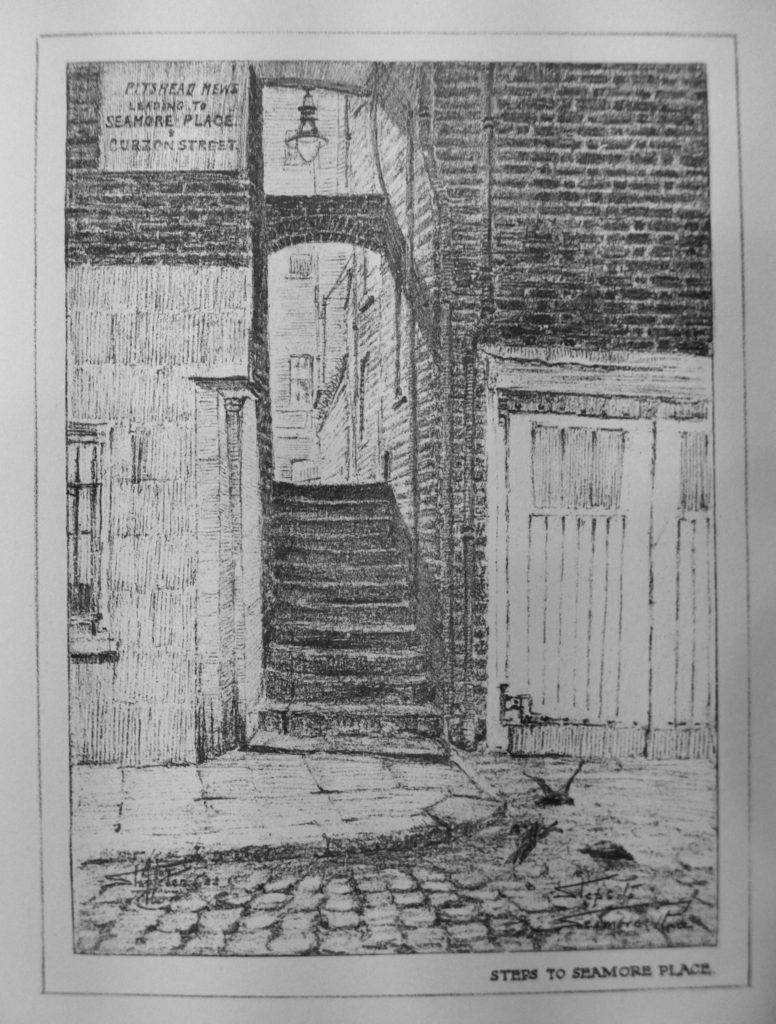


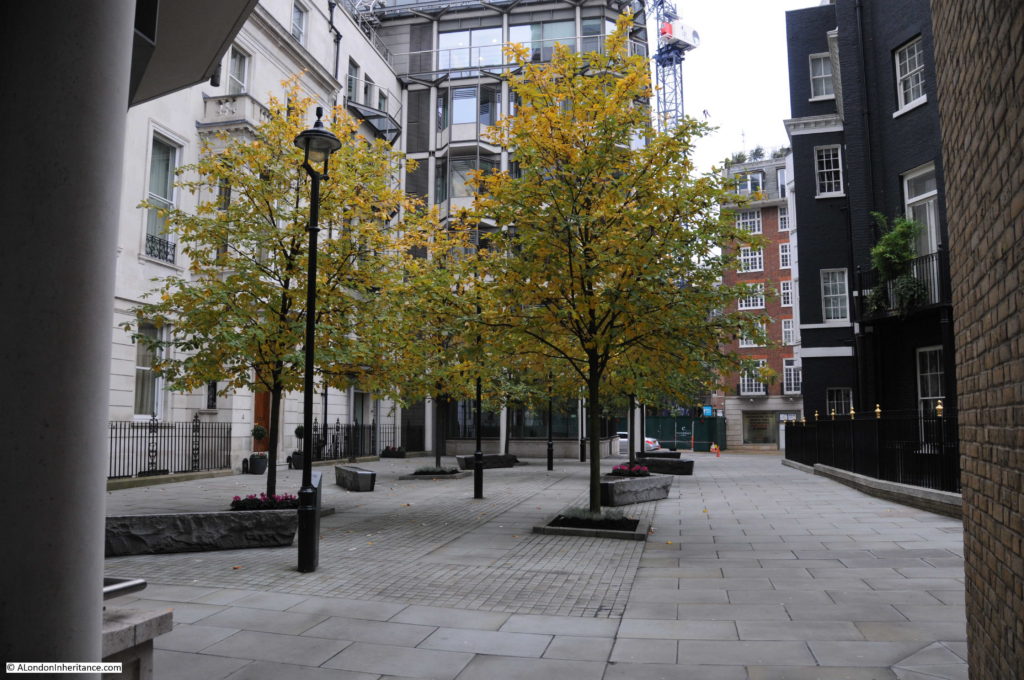
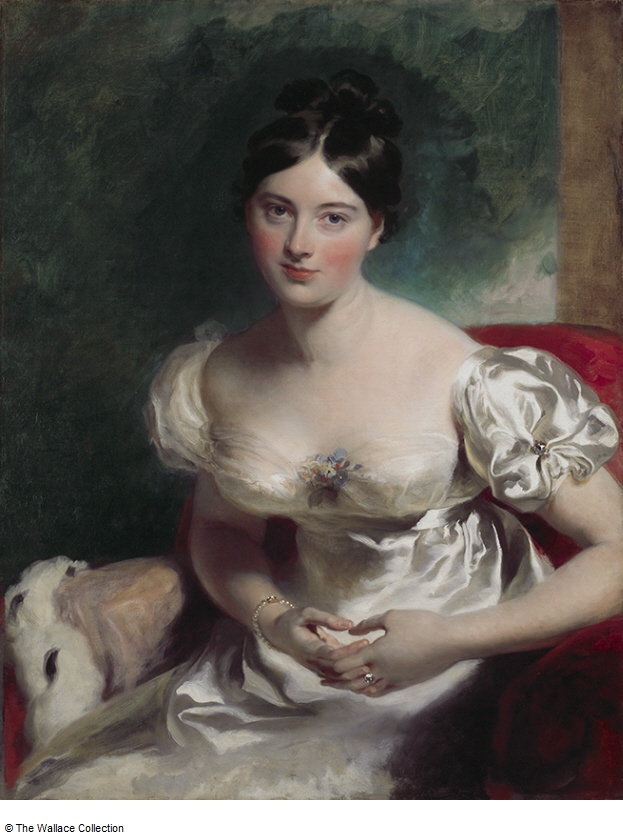
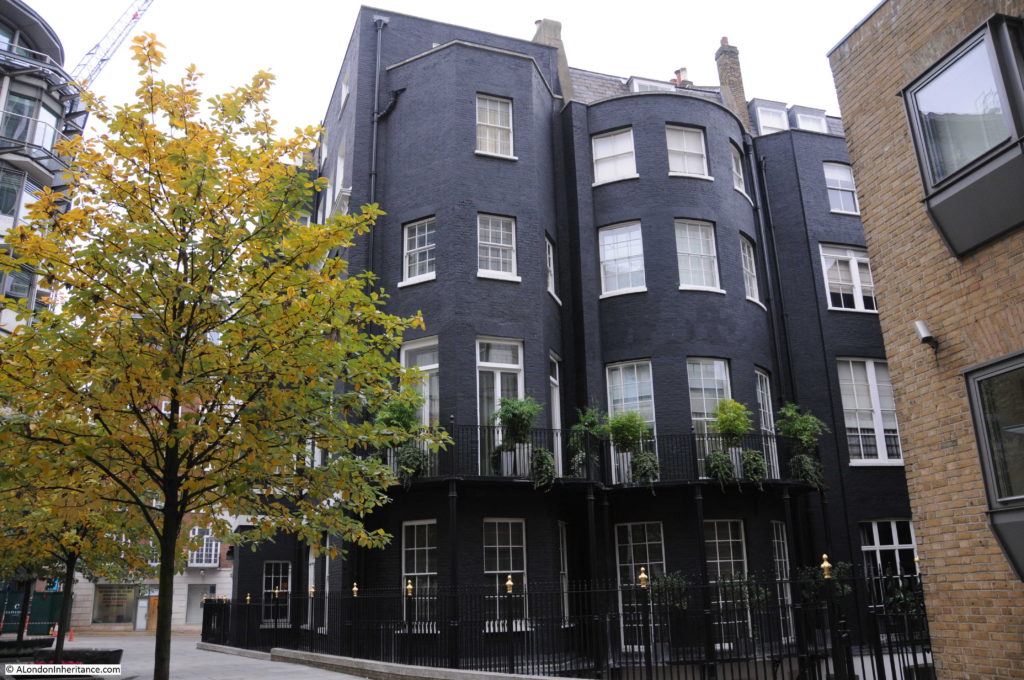
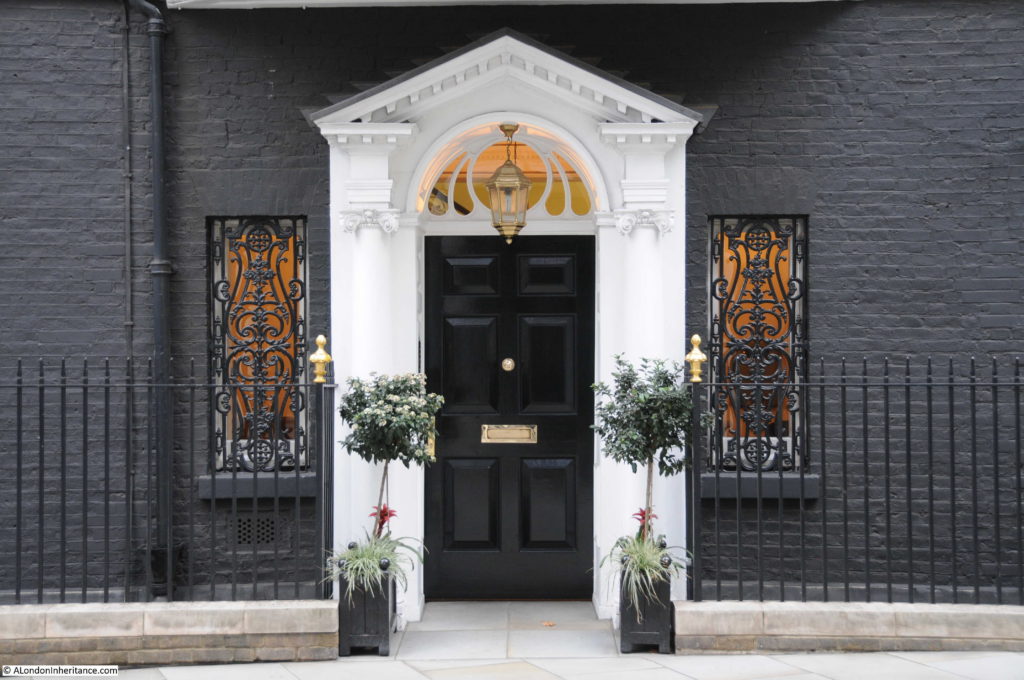
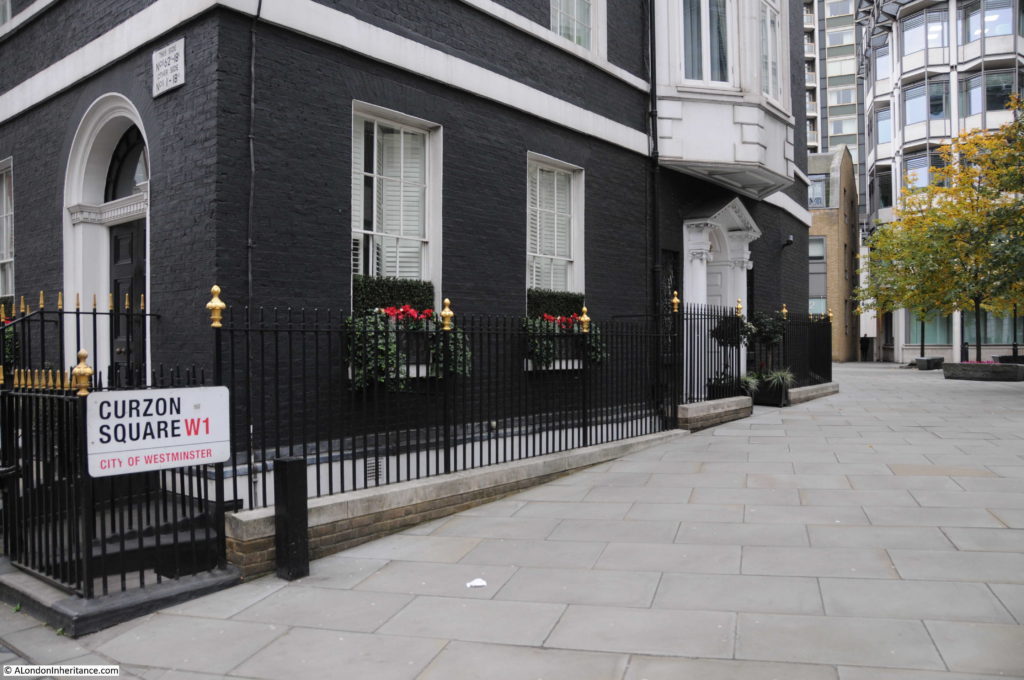
Thanks so much for bringing so much together about what for many like myself is just a curious little cut through. Will seek out the Stapleton book.
I wonder why the steps are there at all. Well, clearly to take care of a height difference. But is there a natural fall in the land or were Curzon Street and the Square build up on arches, as Cubitt did in Pimlico allowing coal cellars and basements at the front of properties? His mewses at the rear were at true ground level, and these steps do indeed lead to more than one mews.
Would it have been possible to guess the location of the 1951 photo if the street name sign hadn’t been visible? The lampost is standard City of Westminster issue, and Mayfair does have its slopes — Hay Hill for example. So perhaps with or without your readers’ help it might have been identified. But for all the visits I made to Curzon Street when my parents worked there I have never noticed this corner.
A very enjoyable piece in the jigsaw of London’s history, thank you.
Thank you for another fascinating piece, beautifully illustrated with photos and maps. As a photographer and Londoner, I delight in these odd corners of the capital, and your article spurs me to investigate Curzon Square at once.
Ha ha! I have had the Stapleton book for decades and always forget to pack it when travelling to London. I was just about to give it away to a local shop and thought, hmmm, I wonder….
Not giving it away after all.
Thank you so much!!
Curzon Place steps appeared on TV in ‘The Professionals’, in the late 70s – a still photo here:
http://www.mark-1.co.uk/Professionals/c06.htm
This set of steps as photographed by your father are shown in S3 Episode 4 “A hiding to Nothing” The Professionals which must have been filmed in the 1970/80s the street sign and the pillar are clear in the starting sequence of the programme of
You might want to look at this info about 1, Seamore Place, which was one of the buildings demolished. It was rather famous in it’s time according to this, though, having belonged to Alfred de Rothschild. https://family.rothschildarchive.org/estates/46-1-seamore-place
What a pity that. No 1 Seamore Square, the London home of Alfred de Rothschild was demolished. It was famous up to and just after WW1 for its fine interiors and brilliant collection of art and furniture. It was left to his daughter, Lady (Almina)Carnarvon, who sold it in the 1920s and the money went to her husband the 5th Lord Carnarvon to help finance his 17th year of excavating in Egypt, and with Howard Carter his partner, they discovered Tutankhamen ‘s tomb.
My ancestor worked at 2 Seamore Place for Lord Ducie. There is info on this address online. Still trying to find when built. 1835 Reno. Drawings. Search words!
Thank you for writing this, It was very helpful. I’m currently working on a few short paragraphs on Dr John Hume, Surgeon to several regiments during the peninsular campaign, Waterloo and the to wellington during his time in office. He lived at 9 Curzon Street by the latest 1838 and is recorded as having died there during 1857.